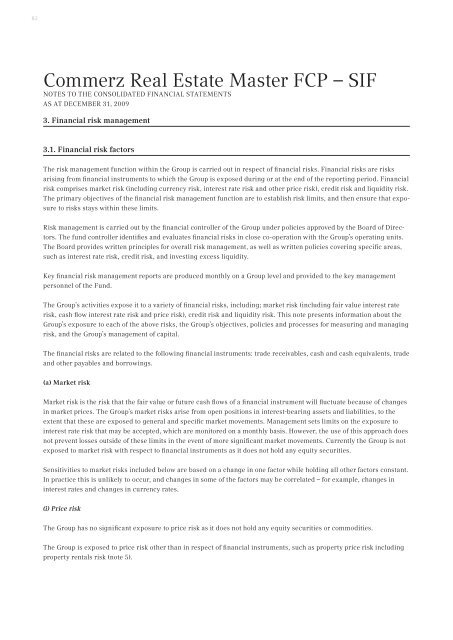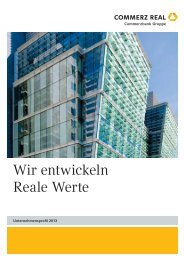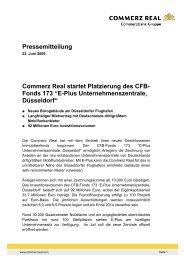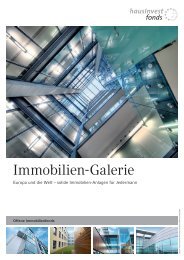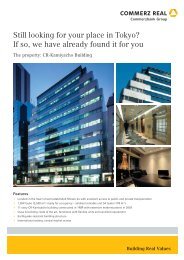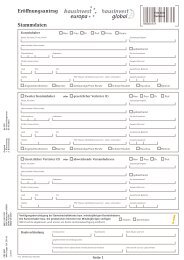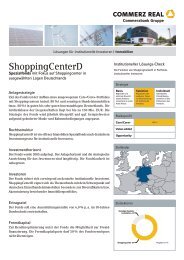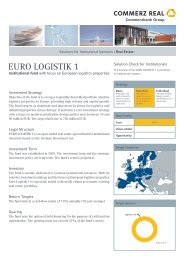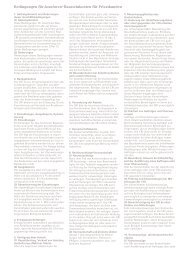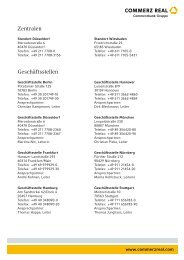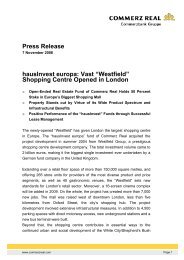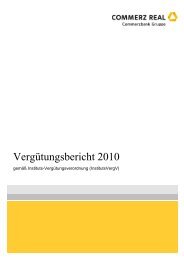CG malls europe - Commerz Real
CG malls europe - Commerz Real
CG malls europe - Commerz Real
Create successful ePaper yourself
Turn your PDF publications into a flip-book with our unique Google optimized e-Paper software.
82<br />
<strong>Commerz</strong> <strong>Real</strong> Estate Master FCP – SIF<br />
NOTES TO THE CONSOLIDATED FINANCIAL STATEMENTS<br />
AS AT DECEMBER 31, 2009<br />
3. Financial risk management<br />
3.1. Financial risk factors<br />
The risk management function within the Group is carried out in respect of financial risks. Financial risks are risks<br />
arising from financial instruments to which the Group is exposed during or at the end of the reporting period. Financial<br />
risk comprises market risk (including currency risk, interest rate risk and other price risk), credit risk and liquidity risk.<br />
The primary objectives of the financial risk management function are to establish risk limits, and then ensure that exposure<br />
to risks stays within these limits.<br />
Risk management is carried out by the financial controller of the Group under policies approved by the Board of Directors.<br />
The fund controller identifies and evaluates financial risks in close co-operation with the Group’s operating units.<br />
The Board provides written principles for overall risk management, as well as written policies covering specific areas,<br />
such as interest rate risk, credit risk, and investing excess liquidity.<br />
Key financial risk management reports are produced monthly on a Group level and provided to the key management<br />
personnel of the Fund.<br />
The Group’s activities expose it to a variety of financial risks, including; market risk (including fair value interest rate<br />
risk, cash flow interest rate risk and price risk), credit risk and liquidity risk. This note presents information about the<br />
Group’s exposure to each of the above risks, the Group’s objectives, policies and processes for measuring and managing<br />
risk, and the Group’s management of capital.<br />
The financial risks are related to the following financial instruments: trade receivables, cash and cash equivalents, trade<br />
and other payables and borrowings.<br />
(a) Market risk<br />
Market risk is the risk that the fair value or future cash flows of a financial instrument will fluctuate because of changes<br />
in market prices. The Group’s market risks arise from open positions in interest-bearing assets and liabilities, to the<br />
extent that these are exposed to general and specific market movements. Management sets limits on the exposure to<br />
interest rate risk that may be accepted, which are monitored on a monthly basis. However, the use of this approach does<br />
not prevent losses outside of these limits in the event of more significant market movements. Currently the Group is not<br />
exposed to market risk with respect to financial instruments as it does not hold any equity securities.<br />
Sensitivities to market risks included below are based on a change in one factor while holding all other factors constant.<br />
In practice this is unlikely to occur, and changes in some of the factors may be correlated – for example, changes in<br />
interest rates and changes in currency rates.<br />
(i) Price risk<br />
The Group has no significant exposure to price risk as it does not hold any equity securities or commodities.<br />
The Group is exposed to price risk other than in respect of financial instruments, such as property price risk including<br />
property rentals risk (note 5).


